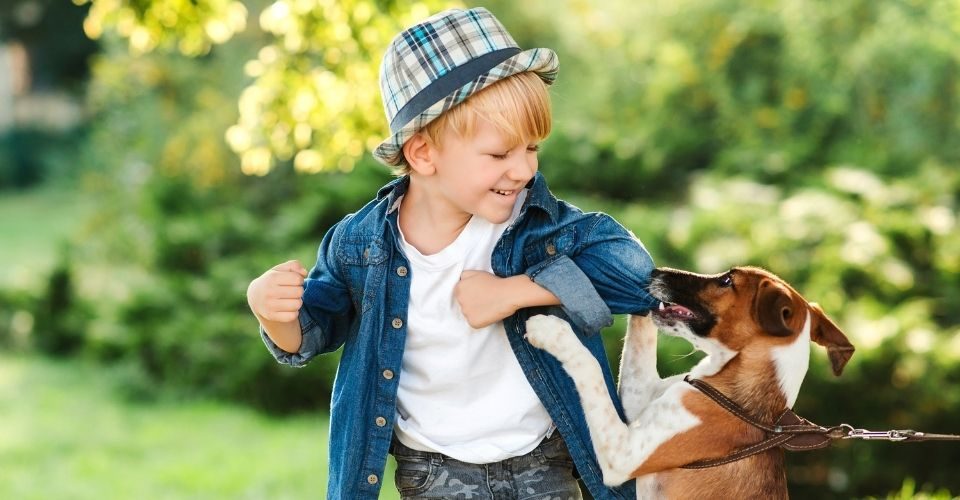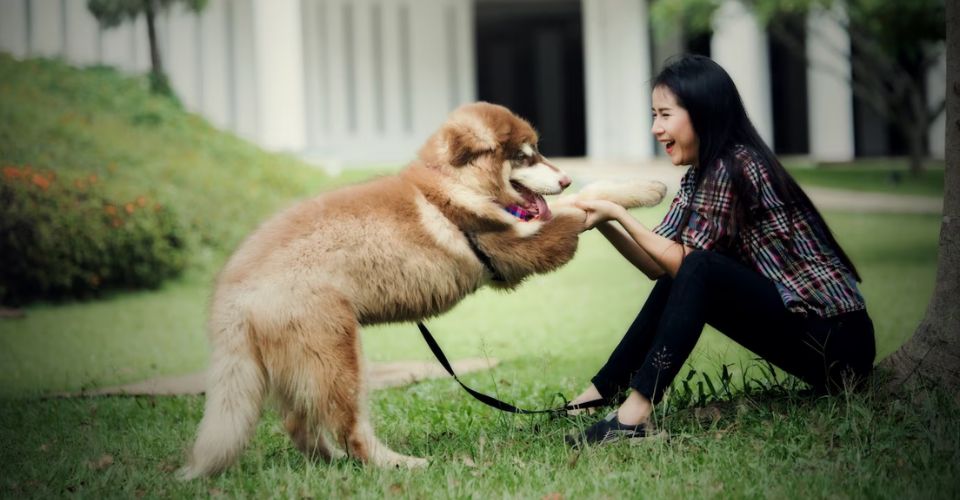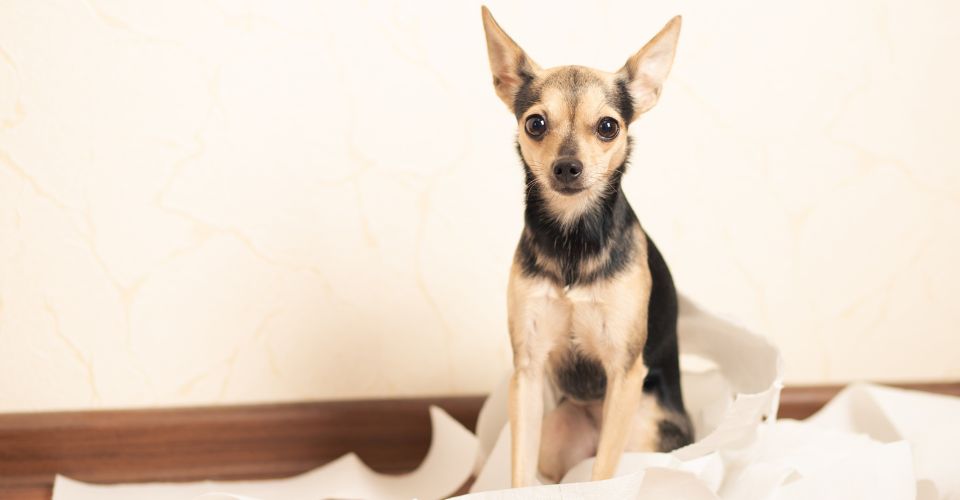Puppies begin teething at the age of 3 weeks or so, and the process completes in 6 weeks. During this time, pups experience irritation and the urge to bite whatever they get their mouths on, even if it’s your hand. While they enjoy biting, they don’t know that their bite is hurting us.
In the early years, pups exhibit some other behaviors such as not listening to their owners, barking excessively, digging, scratching, etc. These are common behaviors because a puppy is yet to be trained for obedience and socialization.
Is your puppy displaying the same behavior? If so, stay with us, and we will walk you through a step-by-step process of how to discipline a puppy.
How To Discipline a Puppy?
Training a dog becomes easy when we delve into where the behavior is coming from.
The first key step in how disciplining a puppy from an early age is to develop a complete understanding of why your pup is acting out.
1. Reasons Behind Stubborn Behavior
A good number of reasons can trigger your puppy’s bad behavior that you may be unaware of. For example, if he is hungry and stubborn, you’d know that. But, if he had his meal and all his needs are fulfilled, you might not know what’s going on.
So, first, we need to have know-how about the possible causes of a puppy being stubborn.
a. Fear-Aggression
Generally, when a person feels afraid of something, he tries to avoid it, exhibiting the flight response. But, somehow, if he has to deal with it, his brain stimulates the fight response. Either he’d fight or his fear would be apparent on his face.
In the puppy world, it’s different!
In their fight response, puppies never show their enemy that they are afraid of them; rather, they get aggressive, snarl at it, and fight.
If not trained, puppies develop a fear of their owners, other puppies, certain situations, loud noises, rush areas, etc. And when they face the thing they fear, they get angry, try to run towards it, not listening to your calls at all.
In your terms, he is stubborn and doesn’t care what you are saying. But in puppy terms, “imma fight that thing master and get back to you.”
b. Boredom
“A tired puppy is a good puppy.”
Boredom is the real setback for a puppy.
Instinctively, puppies are active and need a certain amount of physical activities and fun games to ward off boredom. Even the laziest puppy can get bored because of inactivity.
And when a puppy is bored, you should be ready to bear with his destructive behaviors, such as refusing to obey you, digging, chewing, trying to escape, etc.
So, if you come home late and your puppy is throwing temper tantrums, know that he is bored and needs hugs and fun.
c. Aggression and Stubbornness
Aggressive means that he is dominant, and dominant means that he is stubborn. But a stubbornness that emerges from the dominance issues of a puppy is destructive.
In this condition, the puppy will not listen to your commands. Rather, he’ll bite you if you try to make him do something.
Pretty dangerous situations can occur if your puppy has a stronger body than yours, and there’d be almost no possibility for you to physically overpower him.
d. Separation Anxiety
In simple words, separation anxiety refers to the anxiety and stress felt by a puppy when his owner leaves him. Consequently, puppies release their anxiety by exhibiting destructive behavior to the extent that it can lead to self-hurt and a complete wrecking of household exit points.
Separation anxiety is prevalent in senior puppies as they feel bad about them being unable to please their owners.
Post-COVID, this anxiety will be common as kids, and family members will resume their pre-COVID routines.
e. Small Puppy Syndrome
Puppies hate to put out their vulnerabilities and get sympathy. Sure, they do like attention and love but based on their abilities and eagerness to please the owner, not because they are weak and fragile.
The same is the case with small puppies. They know that they are delicate and can easily be dominated, so they build a wall of aggression and stubbornness around them to make a show of how formidable they are. This is what small puppy syndrome is all about.
Ever seen a Chihuahua playing mean, growling, snarling, and not listening to his parents? That’s because they are trying to get the feel of being a leader.
f. Focus Issues and Distractions
Puppies have focus issues when there are cycles, kids, cars, butterflies, other puppies, etc., around them. Even a little distraction can make them disobey you and follow their own instincts.
Though this issue is common in all dogs, hunting group of canines finds it quite hard to stick to their owner’s orders when they smell a scent from the surroundings.
If that’s the case, you can’t call a puppy stubborn, rather you can say he is inattentive.
g. Attention Deficit Hyperactivity Disorder (ADHD)
When it comes to inattentiveness, your puppy may have ADHD or hyperkinesia in which puppies are hyperactive and lose their calm.
Symptoms of puppy hyperkinesia are:
- Hyperactivity
- Distractible
- Lots of fidgeting and circling
- Impulsiveness
- Aggression
- Poor socialization
- Overly Attention-seeking behavior
- Stubbornness
h. Post-Traumatic Stress Disorder (PTSD)
Per research 5 to 17% of canines suffer from post-traumatic stress disorder.
According to Dr. Tori Teller, “the symptoms of PTSD in puppies are similar to those in humans and include chronic anxiety; hypervigilance; avoidance of certain people, places, or situations; sleep disturbances; fear of being alone; decreased interest in a favorite activity; or aggression.”
She further adds, “we don’t always know what may cause PTSD in puppies, but some potential causes are military or police work, being a bait or fighting puppy, being raised in a puppy mill, severe abuse, living as a stray after being abandoned, trauma from a disaster (flood, fire, earthquake, tornado, explosion), or being attacked by other puppies or animals,”
If a puppy is suffering from PTSD, he’d be less likely to comply with you and get detached.
i. Psychoneurosis
Puppies that have undergone traumas and social derision are likely to be emotionally unstable and neurotic. They display erratic behaviors, such as following their own tail, biting their skin, jumping at imaginary things, etc. A common human may think it is funny and derive pleasure from it but it is not funny.
Such puppies live in their own world, and it’s difficult for them to follow the commands—they behave as if they didn’t listen to the orders at all.
2. How to Discipline a Puppy?
Disciplining a puppy means that you are teaching him how to behave. It’s best to consider your puppy’s brain as a blank page that you have to fill with how you want him to behave. Follow positive behavior along with a bunch of treats and appreciation to get through this task smoothly.
a. Timing
While getting trained, puppies think more about treats and less about the task.
For example, if you are training them to sit or stay, give them treats to lure your puppy into a sit position and as soon as he sits down, give him treats. Remember to put treats in his mouth quickly, or he will forget the reason why he is being rewarded.
b. Go Slowly
Bombarding your puppy’s brain with so much information at the very first time will just overwhelm him. Try taking it slow. Start by training him inside for a longer span of time and give him more treats.
Gradually add distractions, increase time, and decrease the number of treats. The change should be so subtle that the puppy won’t be able to notice it.
c. Control the Environment
During the obedience training sessions begin with an area devoid of toys, TVs, kids, puppies, etc. In this way, puppies will focus only on you, and that will help with training. If you want your puppy to be attentive, you need to train him so.
Later on, perform these drills outside the house.
d. Choose the Right Rewards
Think if you perform well at your job, but your boss gives you the same drab appreciation and no incentive, will you get motivated to perform better next time?
Similarly, when a puppy learns a new trick, motivate him by giving yummy treats and new toys instead of killing the fun part with routine meals.
The yummier the treat, the more quickly the puppy will learn.
e. Be Consistent and Patient
“Perseverance is the key.”
This is the point that puppy owners miss out on while training their puppies. Even a human baby takes years to get used to his parents’ routine. How come a 2 – 3 months old puppy can learn a trick within a matter of 2 or 3 days?
Repetition, consistency, and perseverance are the three must-be-remembered facts while training your puppy to nip out his stubbornness.
3. Effectively Using Positive Reinforcement
Training your puppy with love and affection may also take a considerable amount of time unless they are used smartly.
a. Keeping the Command Short
If you are teaching your puppy to “stay” by giving him treats and appreciation, it’s good. But if you feed him treats and say “hey buddy, I want you to stay in a calm position and leave all the distractions when I say ‘stay’.”
Will he get it? Obviously not, he’d just stare at your hand expecting a treat, nothing else.
So, use simple words and repeat the training until he learns to go with the flow.
b. Creating a Bond of Love and Affection
Training will be effective if you give them a lovey-dovey warm-up. Tickling, rubbing, petting, and kissing your puppy can help you achieve that level of understanding where his brain will be receptive to your commands. Puppies love to please their owners, and if trained with affection, they are naturally inclined to learn obedience in no time.
4. How Punishments Can Make a Puppy More Stubborn?
According to Debra Horwitz, a professional puppy behaviorist, “punishment is any intervention intended to decrease the occurrence of an action or behavior. Commonly utilized punishments against puppies and cats include throwing items at them, yanking on a choke collar or a prong collar, intimidation with a finger, electric shock devices, and physical corrections, such as lifting, kneeling, pushing, jabbing or pinning.”
Once you start treating your puppy badly, he can get under mental stress, instigating his bad behavior and making him more stubborn. Not only this but the bonding that you and your puppy have will also be ruined completely.
Per the same research, “pets may become confused or conflicted if they cannot determine whether the approaching hand represents a friendly gesture or another incident of punishment.”
Staring down at your puppy, dragging him by a leash, holding him down, shouting loud at him, etc., will just trigger his destructive side only.
Owners need to remember that if they keep punishing their puppies instead of telling them what they have done wrong, it’s never going to lead them anywhere.
Try to teach your pup fondness and tenderness, greet him with open arms and positive vibes, play with him often, and don’t leave him alone for long. Caress them and squish their cheeks and say cheesy words, “good baby, good champ, my baby”. Though they don’t understand what you are saying, they are smart enough to sense the positivity and aura of love.
Puppies respond to appreciation rather than scolding. If you understand them, you can inhibit them from biting and nipping.
5. Is Leashing a Stubborn Puppy a Punishment?
Leashing is a punishment if you are using it to hurt your puppy instead of giving him a sense of safety and protection.
Aggressively pulling your puppy using a leash will not only make him choke, but also create a fear of the leash. If you want to take hold of a stubborn puppy, get him leash-trained. Make him think that strip is his toy, not a rope to strangle his delicate neck.
6. How Do You Train A Puppy Not To Bite?
Teething is the instinct of puppies, so it shouldn’t be reprimanded. Instead, they should be trained on how not to bite.
- If the puppy has something like a glove or something he can’t easily swallow or isn’t very dangerous, grasp the item and gently give some resistance while looking into his eyes, and use a serious low tone to say, “drop it.” He will likely feel uncomfortable with your stare and low tone, and let go. Simply say, “good.” Do not go overwhelmingly praising him or giving him a treat as he may think it is a fun game and will want to play it often.
- If your puppy is teething, give them chew toys so they can satiate the urge to bite on something. If you hold a puppy, he’d likely lick your fingers or bite it a little. While you may find it cute, don’t appreciate them, take your hand out immediately. He’d know it’s not right.
- If your puppy is biting excessively, it indicates its elevated energy levels. In this situation, you need to be one step ahead of them. Whenever you see your puppy is about to bite something, immediately place a toy in his mouth. It will keep his teeth sharp as well as inhibit his biting tendency.
As per vets’ recommendations, until your puppy has not given up on biting and undisciplined behavior, isolating them won’t help out.
“Housing the puppy in isolated areas where there is minimal human contact, such as in a laundry room or basement, should be avoided.”
If none of this helps out, consider consulting a professional vet to see if your puppy has underlying health issues furthering his negative tendencies. How to discipline a puppy? Whether it’s obedience, socialization, or any other behavior correction, all training drills should be performed by using the tools of love, affection, and yummy treats.





